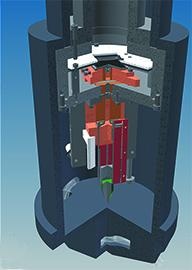Mar 1 2016
A team of researchers from several European countries has used a low-dose electron diffraction technique to determine the structures of nanocrystalline pharmaceuticals.
 90° cut-off schematic of the camera as designed for the CM200 (Technische Universiteit Delft, The Netherlands). (Credit: van Genderen et al)
90° cut-off schematic of the camera as designed for the CM200 (Technische Universiteit Delft, The Netherlands). (Credit: van Genderen et al)
Data regarding the structure of pharma compounds should be consistent for ensuring the safety of patients, for patenting purposes, and for developing the associated medical drugs. However, in actual cases, it is very difficult to analyze the structure of these pharma compounds. This is because different polymorphs are formed by packing separate molecules in a solid compound in several ways. The relevant characteristics of the polymorphs like bioavailability, stability, or the rate at which they dissolve in the abdomen may differ from one another. Hence, analysis of single crystals using normal X-ray diffraction methods will not be effective, as the results obtained cannot represent a bulk sample or may not be available altogether.
When the X-ray diffraction technique is used to analyze these compounds, the high energy emitted by x-rays can potentially damage them. Given that electrons are less damaging when compared to X-rays by several orders of magnitude, the use of low-dose electron diffraction is considered to be a more suitable option, especially when there are only nanometer-sized crystals to analyze. In addition, when the sample is cooled to liquid-nitrogen temperatures, the damage induced by radiation is reduced to a large extent; however, the compound may have a different structure following cooling. As a result, the structure that is obtained does not reflect the actual material ingested by the patient at room temperature conditions.
To resolve these issues, the research team used low-dose electron diffraction and rotated the sample, making sure that separate nanocrystals are not exposed to the electron ray for a long time, and then obtaining the diffraction data by utilizing a CERN-developed detector. The novel detector includes features such as high sensitivity, high signal-to-noise ratio, and high dynamic range to single electrons. Since the damage caused by radiation was not pronounced, sample cooling was not required. This enabled the researchers to analyze nicotinic acid (vitamin B3) and the anticonvulsant drug, carbamazepine, at room temperature. High-quality data was also obtained, which could be used to resolve the structures of both compounds by applying direct techniques and x-ray crystallography software.
With the knowledge of these experimental studies, the researchers plan to further enhance their experimental framework and intend to work towards customized programs for handling data obtained from electron-diffraction.
Source: http://www.iucr.org